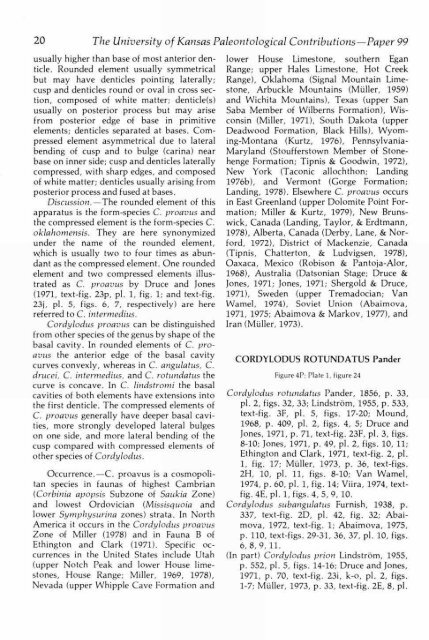View - KU ScholarWorks - University of Kansas
View - KU ScholarWorks - University of Kansas
View - KU ScholarWorks - University of Kansas
Create successful ePaper yourself
Turn your PDF publications into a flip-book with our unique Google optimized e-Paper software.
20 The <strong>University</strong> <strong>of</strong> <strong>Kansas</strong> Paleontological Contributions-Paper 99<br />
usually higher than base <strong>of</strong> most anterior dentide.<br />
Rounded element usually symmetrical<br />
but may have denticles pointing laterally;<br />
cusp and den tides round or oval in cross section,<br />
composed <strong>of</strong> white matter; denticle(s)<br />
usually on posterior process but may arise<br />
from posterior edge <strong>of</strong> base in primitive<br />
elements; denticles separated at bases. Compressed<br />
element asymmetrical due to lateral<br />
bending <strong>of</strong> cusp and to bulge (caria) near<br />
base on inner side; cusp and denticles laterally<br />
compressed, with sharp edges, and composed<br />
<strong>of</strong> white matter; den ticles usually arising from<br />
posterior process and fused at bases.<br />
Discussion. -The rounded element <strong>of</strong> this<br />
apparatus is the form-species C. proavus and<br />
the compressed element is the form-species C.<br />
oklahomensis. They are here synonymized<br />
under the name <strong>of</strong> the rounded element,<br />
which is usually two to four times as abundant<br />
as the compressed element. One rounded<br />
element and two compressed elements illustrated<br />
as C. proavus by Druce and Jones<br />
(1971, text-fig. 23p, pl. 1, fig. 1; and text-fig.<br />
23j, pl. 5, figs. 6, 7, respectively) are here<br />
referred to C. intermedius.<br />
Cordylodus proavus can be distinguished<br />
from other species <strong>of</strong> the genus by shape <strong>of</strong> the<br />
basal cavity. In rounded elements <strong>of</strong> C. proavus<br />
the anterior edge <strong>of</strong> the basal cavity<br />
curves convexly, whereas in C. angulatus, C.<br />
drucei, C. intermedius, and C. rotundatus the<br />
curve is concave. In C. lindstromi the basal<br />
cavities <strong>of</strong> both elements have extensions into<br />
the first denticle. The compressed elements <strong>of</strong><br />
C. proavus generally have deeper basal cavities,<br />
more strongly developed lateral bulges<br />
on one side, and more lateral bending <strong>of</strong> the<br />
cusp compared with compressed elements <strong>of</strong><br />
other species <strong>of</strong> Cordylodus.<br />
Occurrence. -C. proavus is a cosmopolitan<br />
species in faunas <strong>of</strong> highest Cambrian<br />
(Corbinia apopsis Subzone <strong>of</strong> Saukia Zone)<br />
and lowest Ordovician (Missisquoia and<br />
lower Symphysurina zones) strata. In North<br />
America it occurs in the Cordylodus proavus<br />
Zone <strong>of</strong> Miller (1978) and in Fauna B <strong>of</strong><br />
Ethington and Clark (1971). Specific occurrences<br />
in the United States include Utah<br />
(upper Notch Peak and lower House limestones,<br />
House Range; Miller, 1969, 1978),<br />
Nevada (upper Whipple Cave Formation and<br />
lower House Limestone, southern Egan<br />
Range; upper Hales Limestone, Hot Creek<br />
Range), Oklahoma (Signal Mountain Limestone,<br />
Arbuckle Mountains (Müller, 1959)<br />
and Wichita Mountains), Texas (upper San<br />
Saba Member <strong>of</strong> Wilberns Formation), Wisconsin<br />
(Miller, 1971), South Dakota (upper<br />
Deadwood Formation, Black Hills), Wyoming-Montana<br />
(Kurtz, 1976), Pennsylvania-<br />
Maryland (Stoufferstown Member <strong>of</strong> Stonehenge<br />
Formation; Tipnis & Goodwin, 1972),<br />
New York (Taconic allochthon; Landing<br />
1976b), and Vermont (Gorge Formation;<br />
Landing, 1978). Elsewhere C. proavus occurs<br />
in East Greenland (upper Dolomite Point Formation;<br />
Miller & Kurtz, 1979), New Brunswick,<br />
Canada (Landing, Taylor, & Erdtmann,<br />
1978), Alberta, Canada (Derby, Lane, & Norford,<br />
1972), District <strong>of</strong> Mackenzie, Canada<br />
(Tipnis, Chatterton, & Ludvigsen, 1978),<br />
Oaxaca, Mexico (Robison & Pantoja-Alor,<br />
1968), Australia (Datsonian Stage; Druce &<br />
Jones, 1971; Jones, 1971; Shergold & Druce,<br />
1971), Sweden (upper Tremadocian; Van<br />
Wamel, 1974), Soviet Union (Abaimova,<br />
1971, 1975; Abaimova & Markov, 1977), and<br />
Iran (Müller, 1973).<br />
CORDYLODUS ROTUNDATUS Pander<br />
Figure 4P; Plate 1, figure 24<br />
Cordylodus rotundatus Pander, 1856, p. 33,<br />
pl. 2, figs. 32, 33; Lindstriim, 1955, p. 533,<br />
text-fig. 3F, pl. 5, figs. 17-20; Mound,<br />
1968, p. 409, pl. 2, figs. 4, 5; Druce and<br />
Jones, 1971, p. 71, text-fig. 23F, pl. 3, figs.<br />
8-10; Jones, 1971, p. 49, pl. 2, figs. 10, 11;<br />
Ethington and Clark, 1971, text-fig. 2, pl.<br />
1, fig. 17; Müller, 1973, p. 36, text-figs.<br />
2H, 10, pl. 11, figs. 8-10; Van Wamel,<br />
1974, p. 60, pl. 1, fig. 14; Viira, 1974, textfig.<br />
4E, pl. 1, figs. 4, 5, 9, 10.<br />
Cordylodus subangulatus Furnish, 1938, p.<br />
337, text-fig. 2D, pl. 42, fig. 32; Abaimova,<br />
1972, text-fig. 1; Abaimova, 1975,<br />
p. 110, text-figs. 29-31, 36, 37, pl. 10, figs.<br />
6, 8, 9, 11.<br />
(In part) Cordylodus prion LindstrOrn, 1955,<br />
p. 552, pl. 5, figs. 14-16; Druce and Jones,<br />
1971, p. 70, text-fig. 23i, k-o, pl. 2, figs.<br />
1-7; Müller, 1973, p. 33, text-fig. 2E, 8, pl.
















